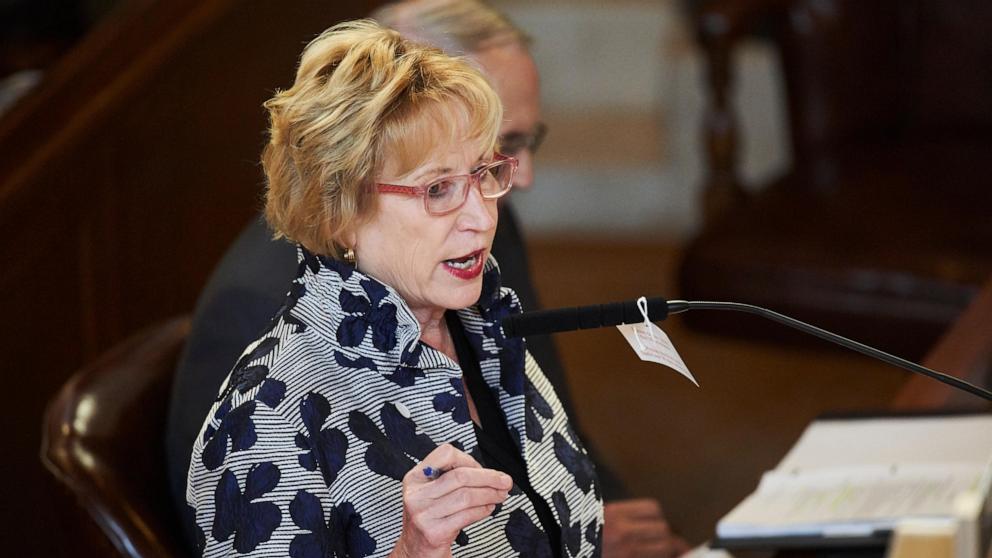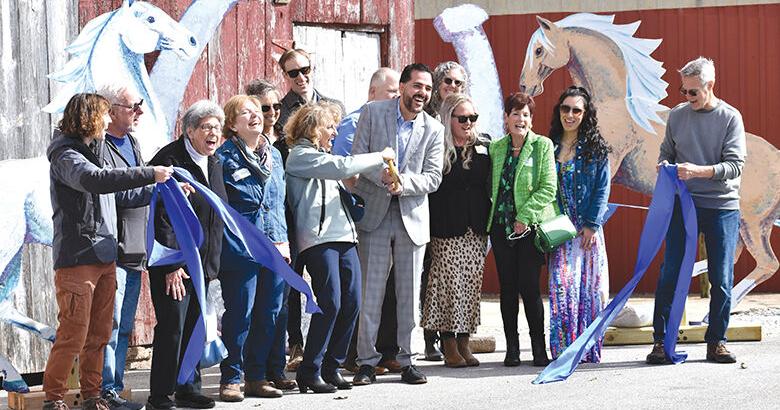Angela Rayner purchased a four-bedroom property after she and her husband made almost £200,000 selling their former council houses.
The couple appear to have made around £182,500 after selling two homes they owned in the Stockport area of Greater Manchester in the mid 2010s.
Ms Rayner is facing scrutiny over whether she or Mark Rayner, her husband at the time, paid the right amount of capital gains tax when the two properties were sold.
Despite the couple both selling their homes, Ms Rayner was the sole owner of their new four-bedroom house, bought in 2016.
Ms Rayner sold her council house on Vicarage Road for a gain of £48,500 in March 2015 while Mr Rayner made £134,000, when he sold his in April 2016.
That same month, almost a year after Ms Rayner was elected MP, she purchased a £375,000 property in her new constituency of Ashton-under-Lyne.
The four-bedroom red brick house has three reception rooms, a large secluded garden and two detached garages, according to the Rightmove listing from the time.
The deputy Labour leader sold her house in Vicarage Road for £127,500 in 2015 and, according to official Land Registry documents, bought the property in Ashton-under-Lyme.
On the same day Ms Rayner bought the house, her husband sold his Lowndes Lane home for £145,250, according to Rightmove.
However, despite Mr Rayner being listed on the electoral roll for the property from 2017 along with Ms Rayner and her son Ryan Batty, she is the only proprietor named on official documents. The couple are understood to have separated in 2020.
In 2022, Mr Rayner applied for home rights under the Family Law Act, which prevents one person from being able to sell a house and leave the other homeless.
Greater Manchester Police is investigating whether any offences were committed, and is understood to have spoken to neighbours about Ms Rayner’s living arrangements.
Ms Rayner has repeatedly insisted she has done nothing wrong, but has declined to publish details of her tax affairs. She has said she will “do the right thing and step down” if she is found to have committed a criminal offence.
The Labour Party and Greater Manchester Police have been contacted for comment.
Community members gather to support over 700 students who were duped by “ghost” immigration consultants in a protest in Mississauga, Ont. on June 14, 2023.Christopher Katsarov/The Globe and Mail
The federal government has come under fire for failing to bring in measures it promised five years ago to crack down on unethical and fraudulent immigration consultants, with the Conservatives demanding to know why a compliance regime is not yet in force.
Last year, a group of international students applying for permanent residence faced deportation after it emerged that an unlicensed “ghost” immigration consultant operating out of India had submitted fake acceptance letters to colleges with their applications for study permits.
Other licensed and unlicensed immigration consultants have been implicated in a jobs-for-sale scam, in which people hoping to work in Canada have been illegally charged thousands of dollars to obtain a job reserved for an immigrant because no Canadian could be found for the position.
The Canada Border Services Agency said that between May 1, 2019, and April 9, 2024, 153 individuals were charged with fraudulent immigration consultant-related offences. The vast majority of them were Canadian citizens or permanent residents, and 17 were foreign nationals – one a refugee.
In a statement, CBSA spokeswoman Jacqueline Roby said people who violate Canada’s immigration laws face criminal charges, court fines, probation or imprisonment. She said investigations largely target the organizers of fraud schemes.
They include scams such as asking for unreasonable fees with the promise of a job offer in Canada, only to see the victim arrive and find no job waiting for them. Some illicit consultants work in collaboration with people trying to come to Canada and knowingly submit fraudulent or misleading applications, Ms. Roby said.
Licensed immigration consultants operating in Canada have expressed concerns about unauthorized practitioners providing unreliable advice. Some have also raised questions about consultants operating outside Canada who are not Canadian.
Earl Blaney, a licensed immigration consultant from London, Ont., said “mass volumes of immigration applications are submitted overseas by unauthorized immigration representatives,” adding that Immigration, Refugees and Citizenship Canada (IRCC) is well aware of the situation.
In 2019, through an omnibus budget bill, the government gave itself the authority to create a regime of penalties, including fines, to deal with violations by anyone providing advice to people making immigration and citizenship applications.
IRCC, in a parliamentary reply three weeks ago to Senator Don Plett, the Conservative leader in the Senate, said the department had not yet imposed any fines on consultants because “the compliance regime for immigration and citizenship consultants is not yet in force” and “the regulatory authorities to do so do not yet exist.”
Paul Chiang, the parliamentary secretary to Immigration Minister Marc Miller, said in the reply that there had been delays in implementing the regime, partly owing to the pandemic.
Immigration Minister announces measures to combat fraud against international students
The department is currently working with the Department of Justice to draft the regulations, and the regime is expected to be in place between this fall and the winter of 2025, he said.
Mr. Plett accused the government of “incompetence” and said he plans to raise the delay in the Senate next week.
“As part of its omnibus budget bill in 2019, the Trudeau government included a new authority for Immigration, Refugees and Citizenship Canada to impose monetary penalties against fraudulent immigration consultants. And here we are five years later, and the program is still not yet in force, and as a matter of fact the regulatory authorities do not yet exist,” he told The Globe and Mail. “Five years ago, the Trudeau government claimed this was important, that it was a priority, and then nothing happened.”
Bahoz Dara Aziz, a spokeswoman for Mr. Miller, said the integrity of Canada’s immigration system has been a top priority for the minister since his appointment to the role last year.
“We are taking steps to address immigration fraud and cracking down on dishonest consultants who seek to abuse our system and take advantage of those seeking to come to Canada,” she said. “We opened the College of Immigration Consultants as the official regulator of consultants with a mandate to protect the public from those who seek to take advantage of newcomers. The college has the power and tools to investigate professional misconduct and to discipline its licensees, and its code of conduct holds consultants to high ethical and professional standards.”
Ottawa plans to create Canadian citizenship path for undocumented immigrants
The college oversees the 11,749 licensed immigration consultants in Canada, as well as 231 working outside the country.
Between July 1, 2022, and June 30, 2023, it dealt with 755 complaints about consultants, 22 of whom faced disciplinary action. Twenty faced suspension, interim suspension or revocation of their licences.
Earlier this year the college revoked the licence of Manitoba immigration consultant Harar Singh Sohi for job selling and other misconduct. Under provincial law, it is illegal to collect a fee for finding a job for a foreign worker.
Stef Lach, spokesperson for the college, said it has been raising public awareness about unlicensed consultants who provide immigration advice for a fee. Its social media campaign has run in Canada and in India, China and Nigeria in local languages.
“Regulating licensees through compliance with standards of practice and meeting competency requirements is critical to the protection of the public. This is accomplished through the code of professional conduct and the college’s complaint investigation process,” he said.
He added that licensed immigration consultants do not have to be resident in Canada or Canadian citizens; court decisions involving professional regulators have consistently struck down citizenship requirements imposed on licensees.
But Conservative immigration critic Tom Kmiec said consultants “practising outside the country cannot be reasonably monitored by their college,” which is a problem.
Two major events in recent memory have contributed to the sense that the current generation of young people have had their life chances stolen from them.
The first is the credit crunch and associated financial crisis of 2008, the consequences of which, even now, have yet to be appreciated. When young couples have their application for an affordable mortgage rejected by their bank, the seeds of that decision all too often seem to trace back to the collapse of Lehman Brothers in the United States and the subsequent exposure of the appalling mismanagement of their own organisations by bankers across the world.
The second cause of grief for the living standards and aspirations of the current generation is, of course, the Covid pandemic. Social historians of the future will have their work cut out for them as they seek to reconcile the enthusiasm with which the public demanded the shut down of the economy and the previously unimaginable scale of state support to be paid out to employees for work not done, and the subsequent outrage at the fall in productivity and anaemic wage growth that followed, as if the two factors were entirely unconnected.
Whatever the causes of the current discontent, the despair of Generation Z at the throttling of their aspirations is a palpable political reality, and one with which current and future governments must deal. Young workers face the prospect of not being able to buy their own homes until well into their thirties, or even forties, unless they can rely upon generous handouts from wealthy parents, further institutionalising the disparity between this country’s haves and have-nots. With growth in rents set to outstrip wages for the next three years, the issue will only become more salient.
But the answers to this dilemma from those directly affected fall far short of economic reality. Of course higher wages for less work would suit many; when has such a prospect not been popular? But as the pandemic proved in painful detail, such solutions, while having a short-term attraction, can only store up massive – perhaps insurmountable – problems for the future.
Even the civil service, the backbone of the British establishment, is responding to the long-term economic impact of lockdown by demanding the same pay for 20 per cent fewer hours worked – an indication, were cynical ministers to exploit the claim, that the service is significantly over-staffed with far more employees than the workload might justify.
Unless some top secret economic theory has been unearthed that turns financial orthodoxy on its head and promises extra productivity in exchange for less work and higher, unaffordable wages, the only apparent solution to the current crisis facing people in their twenties seems to me to be for the economy to grow at a far faster rate than has occurred in the last decade, for consumer demand to mirror that growth and for lending institutions to begin to take risks on mortgages.
It might be remembered that the current expectation of home ownership after securing your first job was not a reality for many when the current generation of boomers and Generation X were children. The vast expansion of private home ownership and associated prosperity of the ’80s and ’90s did not come about because of workers’ rights, but because of free market economic policies that freed up the jobs and the financial markets.
If solutions to the current challenges exist, they do not exist in repeating the follies of the dim or recent past: 1970s corporatism and economic lockdowns served only to store up misery for the many. As former chancellor Denis Healey once said, when in a hole, stop digging. A generation reared on positive affirmation from their parents, who were authoritatively assured by them that everything they said, did or painted was marvellous, can no longer rely on other people – particularly the older generation – to solve their problems for them. There is no deus ex machina waiting to swoop to their rescue.
Today’s problems are not new; previous generations faced the same dilemmas, and they suffered a long, difficult road on the way to salvation. The chief difference is that too many of the current generation seem to believe they are so special that they can rely on the magnanimity of the state and their employers to come to the rescue.
A rude awakening awaits.
LINCOLN, Neb. — With no votes to spare, Nebraska lawmakers advanced a bill that would raise the state’s sales tax by 1 cent to 6.5% on every taxable dollar spent — which would make it among the highest in the country.
The bill is key to Republican Gov. Jim Pillen’s plan to slash soaring property taxes, which reached a high of $5.3 billion in 2023 as housing prices have soared in recent years. Because local assessors are required to assess residential property at around 100% of market value, some people — particularly the elderly who are on fixed incomes — are being priced out homes they’ve owned for years because they can’t afford the tax bill, Pillen and others have said.
The bill garnered the 33 votes needed Tuesday to end a filibuster and advance to the second of three rounds of debate in Nebraska’s unique one-chamber legislature. In addition to raising the state’s current 5.5% sales tax and expanding it to include more services — such as digital advertising costs — it would add new taxes to candy and soda pop and would tax hemp and CBD products at 100%.
California currently has the highest state sales tax in the nation, at 7.25%. If the Nebraska bill passes as is, it would match the 6.5% state sales taxes of Arkansas, Kansas and Washington, which all currently tie for 9th highest in the nation.
Because most cities and counties in Nebraska have an additional local sales tax from 1/2-cent to 2 cents on the dollar, the legislation advanced Tuesday would take the total sales tax in some Nebraska cities to 8.5%.
But the bill would also cut sales tax currently added to utility bills — a proposal made to address complaints that a sales tax increase would disproportionately affect lower income people.
Supporters of the bill pushed back on that argument, noting that grocery food items would still be exempt from sales tax in Nebraska. The bill is aimed at higher income residents with more disposable income, not those living in poverty, said Omaha Sen. Lou Ann Linehan.
For those struggling to get by, “are you spending a lot of money on handbags?” Linehan asked. “Are you spending $200 on new shoes? This bill affects people who have money to spend on those things.”
Linehan has struggled to find enough votes to advance the bill, and paused debate on it last week in an effort to scrounge up more support. It appeared to be headed for failure Tuesday after initially getting only 32 votes — one short — to end debate. It got the 33rd vote from Republican Sen. Steve Erdman, one of the bill’s biggest critics, who switched from not voting to a yes vote in the last second. Erdman supports a sales tax structure that taxes virtually all purchases while eliminating property, income and corporate tax.
Critics of the measure included an unusual mix of both left-leaning opponents, who say a sales tax inherently puts more burden on lower income populations, and conservative ones who oppose any increase in taxes.
State Sen. Jane Raybould — a Democrat in the officially nonpartisan Nebraska Legislature — said that while food may not be subject to sales tax, other necessities like toiletries and cleaning products and more expensive needs like kitchen appliances and vehicles will hurt lower income Nebraska residents. Others also objected to the 100% sales tax on CBD and hemp products, which would drive many businesses that sell them out of business, Omaha state Sen. Jen Day said.
“Fair taxation is always an effort to balance with raising revenue,” she said.
The bill is a tax shift, not a new investment in public education as supporters maintain, taxation watchdog group Open Sky Policy Institute said.
“On average, the 5% of Nebraskans with incomes over $252,600 will pay less as a result of the changes, while for 8 in 10 Nebraskans, the sales tax increase will on average be greater than any property tax cut they may receive,” Open Sky said, citing a study by the Institute on Taxation and Economic Policy.
The bill must survive two more rounds of debate by the end of the legislative session on April 18 in order to pass. Pillen has promised to call lawmakers back for a special session if property tax relief efforts fail to pass.
Opponents across the political spectrum insist they support finding a way to reduce property taxes — but not with a sales tax increase. And some Republican lawmakers now find themselves at odds with the Republican governor over it.
“When you increase taxes to cut taxes, you’re not actually cutting taxes,” Republican state Sen. Julie Slama said. “I’m all for bringing the band back together and having a special session, if that’s what it takes.”
___
This story has been corrected to show that the this year’s legislative session is set to end by April 18.

|
| Việt Nam’s real estate market attracts foreign investors in all segments. — VNA/VNS Photo |
HCM CITY — Việt Nam’s property market is attractive for foreign investors, according to experts.
The attraction is not just in terms of certain locations and segments but across the board.
Nguyễn Trọng Toàn, investment manager at property consultancy Savills’s Hanoi office, said every segment has its own charm for foreign investors.
In the residential segment, they are seeking investment opportunities and developing projects under their own brands amid scarce supply and high demand for housing, he said.
They leverage their advantages in branding, design and construction standards and quality, he said.
In the office segment, the market is seeing growing demand from energy, manufacturing and consulting businesses, which is keeping occupancy rates steady.
In major cities like Hà Nội, Đà Nẵng and HCM City, the segment offers increasing opportunities for foreign investors to position their products to meet green standards such as LEED, WELL and BREEAM certification.
In the Hà Nội property market, Toàn said foreign investors are not focusing just on central districts but are also looking elsewhere.
This is also a move to capture the shift by private offices and the development of urban transportation infrastructure, he said.
In the retail sector, the entry of retail giants underlines the prominence and attractiveness of the country.
In February Central Pattana, a retail powerhouse under Thailand’s leading retail conglomerate Central Group, prepared to establish a legal entity in Việt Nam to enter the vibrant market.
Earlier, after opening its third Emart hypermarket in HCM City, THISO (a subsidiary of THACO) unveiled plans to expand in the north with a fourth by acquiring a 2.4-hectare land plot in the Tây Hồ Tây Urban Area in Hà Nội City.
The hotel segment is also showing signs of recovery.
According to Savills Việt Nam’s Market Report, hotel occupancy rates and tariffs have increased in Hà Nội City and HCM City.
Last year, occupancy rates increased by 21 per cent in Hà Nội City annually and 18 per cent in HCM City.
Foreign investors are more open to various forms of investment to maximise the potential of the market, Toàn said.
After researching the market well, many foreign investors are also considering investment opportunities outside major cities. — VNS
Mark Frie stood Friday inside a nondescript white building in east Tulsa full of thousands of costumes and accessories, and he smiled.
And shook his head. And laughed.
“When we got all this in here, I was just like, ‘I’ll see you all later.’ It is really overwhelming,” said the CEO of the Tulsa Performing Arts Center.
It still is. The old exercise center at Boeing Park is full of rack after rack after rack of costumes. If you’ve got a sartorial need, it can be fulfilled here: tuxedos, Medieval and Victorian dresses, faux straw hats, rubber horse head masks.
And so many boxes and containers yet to unpack.
Don’t be fooled — it’s a boon for the local theatrical community, unfolding one cataloged piece of clothing at a time.
People are also reading…
It all began several years ago with a city councilor who was losing her day job. Crista Patrick worked 15 years at the University of Tulsa, where she ran the Theatre Department’s costume shop and taught classes.
When TU decided to close its theater program, Patrick was out of a job, and 40 years or so of costumes and accessories were suddenly homeless.
Patrick estimates that during her time at TU she would lend her expertise and TU’s treasure trove of costumes to about 50 local productions a year. So she set out to find a new home for what had been the tools of her trade for a decade and a half.
“We don’t have a lot of costumes around this community,” Patrick said. “And so I didn’t want, especially the smaller theaters, to lose that resource.”
After kicking around some ideas, she set her sights on the PAC.
“I wanted a public entity to be in charge. That way it could be equitable for all,” Patrick said. “And so I immediately started calling Mark.”
Patrick jokingly recalled that when she gave Frie and other PAC officials a tour of the costume department in the basement of TU’s Kendall Hall, “they walked around with their mouths hanging open a little bit, and they said, ‘We’ll do it.’”
But how? The PAC didn’t have room for the roughly 12,000 costumes — and countless accessories — that TU would eventually donate.
So Patrick went to work on the city, pleading with them to consider providing storage space. She even shed a few tears — and it worked.
For nearly two years, volunteers have spent several days a month cataloging what is estimated to be a total of 20,000 pieces. They’re not yet half way done.
In addition to the TU contributions, the two local costumers assisting in the project — Alice Wegley and Bruce Lewis — donated the items they have collected during their decades in the business.
Wegley said costumes and accessories have already been loaned to Theatre North, Theatre Tulsa, World Stage Theatre Co. and other local performing arts groups.
“If they say, ‘Hey, I’m looking for this,’ we can look on the computer. Oh, yeah, we have three of those,” Wegley said. “We can send them the pictures of the item, and they can say, ‘Oh, yeah, I want those,’ and then we know. It tells on the computer where it’s at. Each rack has a number, so it tells us exactly where it is.”
Frie said he is grateful to all the parties involved in what he described as a total team effort. The donated costumes from TU and the donated storage facility from the city will allow the PAC to further assist the nonprofit community partners that put on dozens of productions a year at the PAC.
“We felt this was just too important to just let this go into the wind, so to speak,” Frie said. “Part of our philosophy and vision with a PAC Trust is we offset the costs, the expense to be in the Performing Arts Center. We get facility grants to these (local) companies to make it affordable for them to be in our spaces.
“And it just made perfect sense that we could carry on this vision of making sure that not only are we helping you get in the space, but now we can help you costume your show. And it’s just kind of an added layer of how we can serve our groups.”
The new Tulsa World app offers personalized features. Download it today.
Users can customize the app so you see the stories most important to you. You can also sign up for personalized notifications so you don’t miss any important news.
If you’re on your phone, download it here now: Apple Store or Google Play
JEFFERSONVILLE — An agreement has been reached between the Jeffersonville Redevelopment Commission and the Southern Indiana Tourism Bureau regarding the property where the bureau’s offices and visitor center used to be.
City attorney Les Merkley explained the situation during the commission’s meeting Wednesday with the original bureau offices and visitor center located at 305 and 315 Southern Indiana Ave.
He said the building was auctioned at a public sale, and they entered into a purchase agreement with the winning bidder.
SoIN Tourism Executive Director Jim Epperson said a title search was ordered before the start of the auction of the property, but they didn’t receive the results until the end of the auction on Dec. 12, 2023, where they saw the reversion clause.
Epperson said the deed to the property contained a reversion clause that was written in 1996 that states that when the tourism bureau leaves the property, it reverts back to the commission. He said the property was originally sold to the bureau from the commission for $1.
“It was really a protection for both organizations back then,” Epperson said about the clause.
Merkley and Jeffersonville Mayor Mike Moore said discussions were made and agreement was reached between the commission and bureau.
“I’m satisfied with these terms,” Moore said at the meeting.
The tourism bureau will revert the property back to the commission, which will then be sold. Around $396,000 will go toward the commission, while the bureau will receive $455,000.
“I think the portion that we’re getting recognizes the investment that we’ve made over the years, but also respects the original ownership of the redevelopment commission,” Epperson said.
He said the property will be sold to Neace Ventures, and the closing of the sale will occur by the end of April. He said he thanks the attorneys that worked on this agreement with the city and bureau.
“We had great use of that property for 27 years,” Epperson said.
In February, the bureau moved to an office in downtown Jeffersonville at 228 Spring St., Suite 106. Epperson said there has been an “automatic uptick” of foot traffic to the visitor center particularly with residents.
“When that foot traffic really starts taking off with people crossing the bridge and events on the river stage, we know it’s going to be a great location for us,” he said.
Ride On St. Louis has found a permanent home after flooding forced the equine-assisted service program from its home at the Anheuser Estate in Kimmswick five years ago.
The nonprofit organization, which offers equine therapy to children and adults with disabilities, will move its operation to a 27-acre property at 9000 Grab Lane off Sandy Valley Acres Drive northeast of Hillsboro it purchased for about $745,000, said Stephanie Stark, Ride On’s campaign committee adviser.
On March 15, the organization, which was formed in 1998, held a ribbon-cutting and blessing ceremony at its “forever home” with about 35 supporters in attendance.
However, it will be months before staff members and the horses can move there, Stark said.
Marita Wassman, Ride On’s CEO and co-founder, said more fundraising and renovations are needed before the organization may transition to its new home.
She hopes that will happen later this year but until then, services will remain at the group’s leased interim site at 8499 Byrnesville Road in Cedar Hill.
According to the group’s website, approximately $800,000 of the $1.3 million needed for the relocation project has been secured so far.
In addition to acquiring and renovating the property for the organization’s new home, the $1.3 million would provide funds to add staff and expand services, as well as for an endowment.
Stark said the renovations are needed to make it safe for children and adults with disabilities to ride horses at the new property.
She said the property will be ADA (Americans with Disabilities) compliant and PATH (Professional Association of Therapeutic Horsemanship) compliant.
The fields need to be sectioned off and enclosed with about 5,915 feet of fencing. An old barn will be demolished and another will be renovated for six stalls and work areas. Plans also call for a classroom, restroom facilities and parking, Wassman said.
“Additionally, immediate plans include replacing many of the existing wood beams and foundation posts in the barn,” according to the group’s website. “To date, a small structure has already been demolished and removed from the property, and the future barn/stable existing structure has been gutted and prepared for utility updates and grading.”
After the group lost the property in Kimmswick in 2019, the COVID-19 pandemic struck, so most of the therapy staff was furloughed, Stark said.
“So what’s included in that $1.3 million is restaffing the entire organization to be able to provide services, not only for existing participants but also for the (116 people) who are currently on the waiting list for services,” she said.
“We anticipate transitioning our herd in (the third or fourth quarter) of 2024, with program offerings continuing in a limited capacity based upon our herd’s acclimation,” Wassman said. “We will have additional buildout phases and capital improvement projects beyond 2024.”
Wassman said the organization has volunteer opportunities for skilled laborers, and anyone interested in helping with the cause may visit rideonstl.org or call 636-464-3408.
The next fundraiser will be Denim & Diamonds, a private dinner on April 25 at the Fox Run Golf Course Carriage House in the Jefferson County portion of Eureka. For information, email info@rideonstl.org or call 636-464-3408.
Flooding and COVID
Ride On previously was located on the Anheuser Estate along the Mississippi River in Kimmswick, and the property was first affected by flooding in 2013 and then again in 2015, 2016, 2017 and 2018, said BriAnn Session, Wassman’s daughter, who serves as the group’s grant manager.
“It cost Ride on St. Louis approximately $200,000 after every flood to rebuild all their infrastructure,” Stark said.
Session said after each flood, the organization had to close for about eight months while it rebuilt and sanitized affected areas.
When it first moved from Kimmswick in 2019, a friend with a breeding farm in Illinois allowed Wassman to run the organization’s Barn Buddies program from his property for that year.
In 2020, Ride On St. Louis leased the stable in Cedar Hill.
“Before moving there, we had a lot of work to do,” Session said. “We had to clean the pastures out; they were very overgrown. It was vacant for years. We had to build out stalls and temporary fencing that we can bring with us.”
When COVID shut everything down in March 2020, Session said the group was one of the first to offer a virtual equine services program.
Then, after COVID, the organization provided what services it could in Cedar Hill, but the temporary property was not appropriate for anyone in a wheelchair, which makes up a large percentage of the population the organization serves, Stark said.
Session said the organization put a lot of planning into exactly how the new property needs to flow.
At its peak and before the group moved out of Kimmswick, it was serving 50 clients a week from counties in Missouri and Illinois. Since 1998, it has provided equine-assisted services to more than 2,600 people, and it helped about 270 people last year.
According to its website, Ride On St. Louis relies on private donations, fundraising, volunteer efforts, in-kind gifts and grants.
PHILADELPHIA — When the Taliban gained control of Afghanistan in 2021, Jawad Moradi feared he would be put in prison, or worse.
Five years earlier, he had earned his master of laws degree at Duke University. Because of his U.S. legal education and interaction with colleagues in the United States and elsewhere, he was at risk. And as a member of a minority population that had been targeted by the Taliban, he was even more vulnerable.
kAm“x 925 E@ 9:56 >JD6=7 😕 >J 9@FD6[” 96 D2:5]k^Am
kAmqFE @?6 52J[ 5C6DD65 😕 5C23 4=@E96D E@ 6D42A6 56E64E:@?[ 96 2?5 9:D H:76 EC2G6=65 2 C:D<J C@FE6 =:?65 H:E9 %2=:32? 4964<A@:?ED[ 7C@> z23F= E@ 2 ?@CE96C? AC@G:?46[ H96C6 2? 6G24F2E:@? 7=:89E 2CC2?865 3J 2 56AFEJ 5:C64E@C 2E 2 &]$] F?:G6CD:EJ 4@==23@C2E:G6 2H2:E65 9:>]k^Am
kAmw6 7@F?5 9:>D6=7 😕 2 C67F866 42>A 😕 E96 &?:E65 pC23 t>:C2E6D 2?5 ?62C=J 2 J62C =2E6C 😕 E96 &?:E65 $E2E6D[ 2E E96 &?:G6CD:EJ @7 !6??DJ=G2?:2’D r2C6J {2H $49@@=]k^Am
kAm“(92E H@F=5 x 5@ :7 x 5:5?’E 92G6 E9:D DFAA@CE 7C@> !6??n” |@C25:[ bd[ @7E6? H@?56CD]k^Am
kAm|@C25: 😀 @?6 @7 D:I “2E\C:D< D49@=2CD” E92E !6?? 92D 3C@F89E E@ 42>AFD D:?46 :ED !6?? v=@32= @77:46 =2F?4965 2 ?6H AC@8C2> 😕 a_a`] %96 F?:G6CD:EJ 925 AC6G:@FD=J 96=A65 D49@=2CD[ 3FE E96 4C:D:D 😕 p7892?:DE2? D9@H65 E96 ?665 7@C 2 >@C6 4@@C5:?2E65[ 4@?46CE65 677@CE[ D2:5 $4@EE |@@C6[ AC24E:46 AC@76DD@C @7 A@=:E:42= D4:6?46 H9@ @G6CD66D E96 AC@8C2>]k^Am
kAm%96 @E96C 7:G6 D49@=2CD 4@>6 7C@> p7892?:DE2?[ 2D H6== 2D ‘6?6KF6=2 2?5 &<C2:?6[ |@@C6 D2:5]k^Am
kAm!6?? v=@32= AC@G:56D Sb_[___ 2??F2= DE:A6?5D 7@C FA E@ EH@ J62CD[ 2?5 E96 D49@@= @C 56A2CE>6?E 9@DE:?8 E96 D49@=2C 😀 6IA64E65 E@ >2E49 :E] %96 2AAC@I:>2E6 Se_[___ 96=AD H:E9 9@FD:?8 2?5 @E96C 6IA6?D6Dj E96J 2=D@ 86E @77:46 DA246] !6?? v=@32= 2=D@ 2DD:DED H:E9 G:D2 2AA=:42E:@?D]k^Am
kAm“*@F 42?’E 5@ =@ED 2?5 =@ED @7 A6@A=6[ 3FE J@F 42? >2<6 2 5:776C6?46[” D2:5 tK6<:6= y] t>2?F6=[ G:46 AC@G@DE 7@C 8=@32= :?:E:2E:G6D]k^Am
kAmqC:?8:?8 😕 E96 D49@=2CD 2=D@ 36?67:ED !6?? 724F=EJ 2?5 DEF56?ED[ 96 D2:5[ 8:G:?8 E96> 2 “H:56C G:6H @7 E96 D49@=2CD9:A 92AA6?:?8 😕 @E96C 4@F?EC:6D]”k^Am
kAm%96 D49@=2CD 5@?’E ?646DD2C:=J 92G6 E@ 36 DEF56?ED @C AC@76DD@CDj E96J 42? 36 AF3=:4 :?E6==64EF2=D[ >FD:4:2?D[ 2CE:DED[ ;@FC?2=:DED[ A@=:E:4:2?D[ “2?J@?6 H9@D6 AC6D6?46 H@F=5 255 E@ E96 E6249:?8[ C6D62C49 2?5 D6CG:46 >:DD:@?D @7 E96 F?:G6CD:EJ[” |@@C6 D2:5]k^Am
k9bm!2CE @7 2 ?2E:@?2= 677@CE E@ C6D4F6 D49@=2CDk^9bm
kAm%96 !6?? AC@8C2> 7:ED :?E@ 2 =2C86C 677@CE 3J F?:G6CD:E:6D E@ @776C C67F86 E@ D49@=2CD H9@D6 =:G6D @C H@C< 2C6 6?52?86C65 😕 E96:C 9@>6 4@F?EC:6D]k^Am
kAm%96 x?DE:EFE6 @7 x?E6C?2E:@?2= t5F42E:@?[32D65 😕 }6H *@C< r:EJ[ CF?D E96 =2C86DE AC@8C2> 😕 E96 ?2E:@? 7F?565 E9C@F89 2 Sda >:==:@? 6?5@H>6?E[ 8C2?ED 2?5 5@?@CD] $E2CE65 😕 a__a[ :E 92D 96=A65 `[`_e D49@=2CD 7C@> ea 4@F?EC:6D 7:?5 ?6H 24256>:4 9@>6D 2E d_a :?DE:EFE:@?D H@C=5H:56]k^Am
kAmx? a_ab[ E96 :?DE:EFE6 C646:G65 ?62C=J fd_ 2AA=:42E:@?D 2?5 2H2C565 `af 76==@HD9:AD[ D2:5 |2C< p?86=D@?[ E96 :?DE:EFE6’D 3@2C5 492:C]k^Am
kAmqFE 6G6? 367@C6 E92E[ E96 :?DE:EFE6 @? 2 =6DD 7@C>2= 32D:D H2D 96=A:?8 D49@=2CD[ :?4=F5:?8 E9@D6 A6CD64FE65 3J E96 }2K:D 2?5 E2C86E65 3J E96 q@=D96G:< A2CEJ 😕 #FDD:2[ 96 D2:5]k^Am
kAm“(6 2=H2JD 925 E96 :562 E92E E96 4C:D:D H@F=5 36 @G6C[ E96 H2C H@F=5 36 @G6C[” D2:5 p==2? t] v@@5>2?[ E96 :?DE:EFE6’D 49:67 6I64FE:G6 @77:46C] “xE C62==J H2D?’E F?E:= E96 >:==6??:F>[ H6 C62=:K65 E9:D 😀 2 A6C>2?6?E DE2E6 @7 E96 H@C=5] (6 36EE6C 86E C625J E@ 5@ E9:D 8=@32==J 2?5 A6C>2?6?E=J]”k^Am
kAm%96 :?DE:EFE6 2E 2?J 8:G6? E:>6 😀 DFAA@CE:?8 23@FE `ad D49@=2CD[ H9@ >@DE @7E6? 4@>6 H:E9 E96:C 72>:=:6D] %96J C646:G6 G:D2 2?5 EC2G6= DFAA@CE[ 2 DE:A6?5 2?5 2DD:DE2?46 H:E9 7:?5:?8 9@FD:?8 2?5 25;FDE:?8 E@ E96:C ?6H 4@>>F?:EJ] p3@FE 92=7 C6EFC? E@ E96:C 4@F?EC:6D 27E6C E96 E9C62E A2DD6D[ v@@5>2? D2:5]k^Am
kAmqFE D@>6 DE2J] $2=2> p= zF?E2C2[ 2? 2C4926@=@8:DE H9@ 25G@42E6D 7@C E96 AC@E64E:@? 2?5 AC6D6CG2E:@? @7 4F=EFC2= 96C:E286 D:E6D 😕 96C 9@>6 4@F?ECJ @7 $JC:2[ 3642>6 2? 2DD:DE2?E AC@76DD@C @7 4=2DD:4D 2E #FE86CD 27E6C 96C E:>6 2D 2 D49@=2C 2E !6??]k^Am
kAm~E96C !9:=256=A9:2\2C62 4@==686D E92E 92G6 9@DE65 D49@=2CD E9C@F89 E96 :?DE:EFE6’D AC@8C2> :?4=F56 !6??[ #FE86CD[ sC6I6=[ %6>A=6[ pC425:2 2?5 ‘:==2?@G2[ p?86=D@? D2:5]k^Am
k9bm‘x 42? @C56C 2=>@DE 2?JE9:?8’k^9bm
kAm!2G6= v@=F36G[ bh[ 2 #FDD:2? 2CE 9:DE@C:2?[ 925 366? 9625 4FC2E@C 2E 2 >FD6F> 😕 &<C2:?6 H96? #FDD:2 :?G2565 😕 a_aa] w6 925 =67E #FDD:2 27E6C AF3=:D9:?8 E96 5:2C:6D @7 z@?DE2?E:? $@>@G[ 9:89=:89E:?8 E96 A2:?E6C’D 9@>@D6IF2=:EJ[ 2 A2CE @7 9:D =:76 E92E 925 366? D:=6?465 😕 #FDD:2]k^Am
kAmw6 925 366? :?G:E65 E@ E96 ~56DD2 u:?6 pCED |FD6F> 😕 &<C2:?6 H96C6 96 925 4C62E65 2? 6I9:3:E:@? @? $@>@G 2?5 H2D =2E6C @776C65 2 7F==\E:>6 A@D:E:@? E96C6]k^Am
kAmv@=F36G 2=C625J <?6H y@?2E92? s] z2EK[ 2? 2DD@4:2E6 AC@76DD@C @7 AC24E:46 2E !6?? 😕 9:DE@CJ @7 2CE 2?5 86?56C[ D6IF2=:EJ 2?5 H@>6?’D DEF5:6D] z2EK 925 4@?E24E65 v@=F36G H96? 96 H2D AFEE:?8 E@86E96C “%96 u:CDE w@>@D6IF2=D[” 2? 6I9:3:E:@? E92E @A6?65 @? 2 D>2== D42=6 😕 r9:428@ 2 4@FA=6 @7 J62CD 28@ 2?5 H:== 92G6 2 =2C86C 563FE ?6IE J62C] w6 H2D >2CD92=:?8 2 8C@FA @7 D49@=2CD 7C@> 2C@F?5 E96 H@C=5 E@ 96=A H:E9 E96 6I9:3:E:@?[ H9:49 49C@?:4=6D E96 62C=:6DE 2AA62C2?46D @7 D6IF2= 5:776C6?46 😕 2CE]k^Am
kAmz2EK H2D H@CC:65 23@FE v@=F36G 😕 E96 &<C2:?6 2?5 @776C65 E@ 3C:?8 9:> E@ !6??] v@=F36G H2D 96D:E2?E E@ =62G6 F?E:= 96 4@F=5 2DDFC6 E96 H@C<D 2E ~56DD2 H6C6 D276[ 3FE 6G6?EF2==J 42>6 E@ !9:=256=A9:2 😕 pF8FDE a_aa] v@=F36G 7@F?5 2? 2A2CE>6?E[ 2?5 z2EK’D 4@==628F6D AC@G:565 E96 ?646DD2CJ 7FC?:D9:?8 2?5 DFAA=:6D]k^Am
kAm“x 92G6 7FC?:EFC6 H:E9 2 9:DE@CJ 2?5 AC@G6?2?46[” v@=F36G D2:5 AC@F5=J[ D:EE:?8 😕 E96 9:DE@CJ 56A2CE>6?E @77:46 96 D92C6D H:E9 z2EK]k^Am
kAmw6 AC6D6?E65 9:D C6D62C49 @? $@>@G 2E 2 !6?? 4@==@BF:F> E92E s646>36C 2?5 4@?E:?F6D E@ H@C< H:E9 z2EK @? E96 FA4@>:?8 6I9:3:E:@?] w6 2=D@ 4@?5F4ED 2 C625:?8 8C@FA 7@C 5@4E@C2= DEF56?ED @? BF66C DEF5:6D 😕 2CE 9:DE@CJ]k^Am
kAm“%96 AC@8C2> 5:5 H92E :E H2D DFAA@D65 E@ 5@[ H9:49 H2D E@ 86E D49@=2CD 2E C:D< @FE @7 52?86C[” z2EK D2:5]k^Am
kAmz2EK D2:5 E9C@F89 v@=F36G[ 96 92D =62C?65 23@FE E96 =2C86 #FDD:2? $=2G:4 ?6:893@C9@@5 😕 }@CE962DE !9:=256=A9:2i “xE C62==J H2D H:=5[” 96 D2:5] “x 76=E =:<6 x H2D D@>69@H 😕 t2DE6C? tFC@A6]”k^Am
kAmv@=F36G H2D 2>2K65 2E E96 2446DD E@ 2 H:56 2CC2J @7 >2E6C:2=D E9C@F89 !6??’D =:3C2C:6D] “x 42? @C56C 2=>@DE 2?JE9:?8[” 96 D2:5]k^Am
kAmw6 9@A6D E@ 7:?5 H@C< 2?5 DE2J 😕 E96 &?:E65 $E2E6D 27E6C 96 4@>A=6E6D E96 D49@=2C AC@8C2>]k^Am
k9bm‘|2J36 x D9@F=5 5@ D@>6E9:?8’k^9bm
kAmy6DúD u6C?á?56K\’:==2G6C56[ 2 AC@76DD@C @7 64@?@>:4D[ 962C5 23@FE p?86= p=G2C25@ 7C@> 2 >FEF2= 7C:6?5 H96? 96 H2D G:D:E:?8 2 F?:G6CD:EJ 😕 $A2:?] p=G2C25@[ 9:D 7C:6?5 E@=5 9:>[ H2D 2 ‘6?6KF6=2? 4@?8C6DD>2? 2?5 64@?@>:DE H9@ 925 366? 25G@42E:?8 7@C 56>@4C24J 2?5 :>AC@G65 64@?@>:4 A@=:4J 😕 E96 4@F?ECJ] ‘6?6KF6=2[ u6C?á?56K\’:==2G6C56 D2:5[ 92D 925 E96 H@C=5’D =2C86DE 4@==2AD6 @7 vC@DD }2E:@?2= !C@5F4E 😕 E96 =2DE `__ J62CD 😕 2 4@F?ECJ E92E H2D ?@E 2E H2C]k^Am
kAm“xE H2D ?@E 8@:?8 H6== 7@C 9:>[” u6C?á?56K\’:==2G6C56 D2:5]k^Am
kAmp=G2C25@[ cb[ 925 366? 362E6? 3J A@=:46 2?5 2 7C:6?5 5:65 F?56C DFDA:4:@FD 4:C4F>DE2?46D H9:=6 😕 A@=:46 4FDE@5J 😕 a_`g[ 96 D2:5]k^Am
kAm“x E9@F89E >2J36 x D9@F=5 5@ D@>6E9:?8[” u6C?á?56K\’:==2G6C56 D2:5]k^Am
kAmp=G2C25@ 92D DA6?E E96 =2DE EH@ J62CD 2E !6??] w6 92D 4@\E2F89E 2? @?=:?6 4@FCD6 @? E96 64@?@>:4 9:DE@CJ @7 {2E:? p>6C:42 2?5 :?E6CG:6HD $A2?:D9\DA62<:?8 64@?@>:DED 7@C 2 A@542DE] w6 2=D@ 7:?:D965 9:D 5:DD6CE2E:@?]k^Am
kAmp=G2C25@ H2?ED E@ C6EFC? E@ ‘6?6KF6=2 :7 E96C6 😀 2 C68:>6 492?86]k^Am
kAm“!9:=256=A9:2 7@C >6 92D 366? w62G6? 😕 2 D6?D6[” 96 D2:5] “!6?? 😀 2 E@A F?:G6CD:EJ]]] H:E9 E@A 24256>:4 AC@76DD@CD[ C6D62C496CD]]] 2?5 E96 DEF56?ED 2C6 E@A DEF56?ED 😕 E6C>D @7 249:6G6>6?E 2?5 :562D[ A6@A=6 H9@ H2?E E@ 492?86 E96 H@C=5]”k^Am
k9bm‘yFDE 5C62>:?8’k^9bm
kAmu@C |@C25:[ :E H2D z2C6? w2==[ 56AFEJ 6I64FE:G6 5:C64E@C 2E E96 #F=6 @7 {2H r@==23@C2E:G6 2E E96 &?:G6CD:EJ @7 $@FE9 r2C@=:?2[ H9@ 96=A65 2CC2?86 9:D E:>6 2E !6??] $96 H2D 2DD:DE:?8 D6G6C2= 5@K6? D49@=2CD 86E 7C@> p7892?:DE2? E@ &]$] F?:G6CD:E:6D] $96 C624965 tC:4 u6=5>2?[ 56AFEJ 562? 7@C :?E6C?2E:@?2= AC@8C2>D 2E !6?? r2C6J {2H]k^Am
kAmu6=5>2? D2:5 |@C25: “D9@H65 FA H:E9 2 D>:=6 @? 9:D 7246” 2?5 2D<65 9@H 96 4@F=5 C6A2J !6??] |@C25: E9@F89E 96 H@F=5 92G6 E@ 5@ C6D62C49 @C 4@>A=6E6 @E96C D49@=2C=J 5FE:6D]k^Am
kAmxE H2D E96 @?=J H2J 7@C |@C25: E@ C6>2:? 😕 E96 &?:E65 $E2E6D 2?5 H@C< 2D 2 =2HJ6C]k^Am
kAm|@C25: A2DD65 E96 }6H *@C< q2C =2DE J62C 2?5 8@E 2 ;@3 2E 2 7:?2?4:2= 4@>A2?J 😕 s6=2H2C6] w6’D 2=C625J 366? AC@>@E65 2?5 D6CG6D 2D 4@CA@C2E6 4@F?D6=] w6 2?5 9:D H:76 =:G6 😕 !9:=256=A9:2]k^Am
kAm“$@>6E:>6D[” 96 D2:5[ “x E9:?< >2J36 x’> ;FDE 5C62>:?8]”k^Am
kAmk6>mU4@AJja_ac %96 !9:=256=A9:2 x?BF:C6C[ {{r] ‘:D:E 2E k2 9C67lQ9EEAi^^:?BF:C6C]4@>Qm:?BF:C6C]4@>k^2m] s:DEC:3FE65 3J %C:3F?6 r@?E6?E p86?4J[ {{r]k^6>mk^Am









Consultants are just the sound of cans being kicked down potholed roads
Opinion: Sometimes you read, hear or see something presented and realise it encapsulates matters beyond its immediate scope. Often the insight is not intended. I had that experience this week on reading a report on aged care released by Te Whatu Ora.
The report was prepared by an external consultancy. (Why on earth, with the resources and relationships available to Te Whatu Ora and Manatu Hauora, was it considered necessary or appropriate to pay for an external review on a core part of their work?)
It is, of course, part of a longer review, following the foundation principle of consultancy that any report should ideally function as a job description for the next report.
This first report is a “strategic assessment” of aged residential care and home support services – a description of the current position and concerns. You may not unreasonably have thought that the various people who have for years developed policies for, monitored and funded these activities could have done this work.
If they could not, then they have no shortage of input, including plenty of recent submissions and studies commissioned by those providing such services. So, not surprisingly, what the consultants found after “engaging with the sector” was simply what was already known.
Their policy recommendations will follow but there is more than enough in their first report to make it clear that:
• There is a lot of demand for residential aged care services currently and prospectively for which the facilities, trained people and funding are not available; and
• Though the private retirement village and aged care model may deliver sufficient residential care facilities for about half of the aged population, there is simply no current model for decent levels of such care facilities for the rest.
Those responsible for the sector, turning a blind eye to these facts, comfort themselves (though not the aged) with the thought that home care will fill the gap. The latest report appears geared to buttress this view. But in practice, this pious hope ignores the realities of the available workforce, let alone the cost of delivery, the real care demands of ageing including dementia, the suitability of home facilities and the impact on housing stock. Home-based care is a vital part of a solution but it is not a panacea.
The impact, of course, is most negative on low-income and low or zero-wealth-aged people and their families. The health inequities of a lifetime are intensified in the final stages. It is all depressingly familiar across social services.
So it is a real problem but it is not new nor unknown. It must be confronted and solutions found. This is where my wider concerns kick in, and they extend well beyond wasting resources on consultants to tell us that the wet stuff falling out of clouds is rain.
The same consultant also recently found that the Environmental Protection Authority was much slower on reviewing new agri-chemical products than equivalent overseas jurisdictions (already well known) and that this is directly comparable to the relative funding allocated by successive governments (ditto). The options include reducing local reviews or increasing funding (no prizes for guessing the likely outcome). What they do not analyse (because they were not asked) is whether our environment has been harmed by any delays or what the risks are from looser processes.
The wider concern is that we do not need to spend resources on identifying our problems because the big ones are already obvious. The problem is our collective unwillingness to address them.
Just as aged care shortages and risks of agri-chemicals are well known, so are such matters as the costs of National Superannuation, the absence of wealth or capital gains taxes, poor dental care and many other aspects of public health, shortages of and inappropriate housing, water supply, wastewater and sewerage infrastructure, carbon and methane emissions, and so on. This list seems endless but it is all well known, not remotely new, and mainly housed securely in cans being kicked down a potholed road.
None of these are likely to be fixed by income tax cuts or looser (loser?) regulations. None at all by realignment of defence and spying arrangements. None by removing Māori rights or nomenclature. None by reducing public employment. None by being “open for business”. None needs another expensive report or set of “expert” advisors whose expertise is primarily based on their ideological proximity to the governing parties.
Lists of “priorities” or “targets” may assist in making politicians look busy. Anyone in business is well aware of the danger of being a “busy fool” – vigorously attacking matters that look within reach but are not the most important objectives. In my experience the bigger the list, the bigger the noise about it, the bigger the fool. Same thing applies in government.
The thing is, the really big problems require collective action, they are not the sort of things private business is likely to pick up and solve (which does not exclude private business from being involved in delivery). They also require leadership that has the courage to spell out the large-scale trade-offs involved and to prioritise public welfare over private interest.
Maybe we have had a government like that, but not in my lifetime. As the old folk song had it:
“Everybody’s doin’ something, I heard it in a dream / But when it’s too much of nothin’ it just makes a fella mean”.
Source link